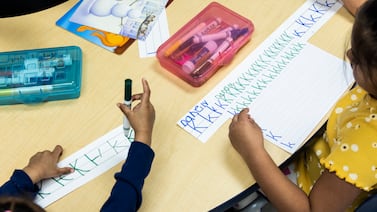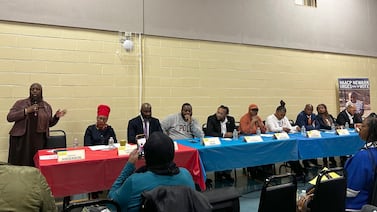Former Mayor Bill de Blasio dramatically expanded free preschool in New York City, an incredibly popular initiative that made it free for every 4 year old.
Now, Mayor Eric Adams is looking to leave his own mark on the early childhood education system, releasing a blueprint on Tuesday for making it easier-to-use for families and more streamlined for providers.
The 38-page plan calls for helping families access care more easily and expanding services to reach 41,000 more children in high-needs neighborhoods over the next two years. It also focuses on strengthening the workforce who serve the city’s youngest children.
“All the research shows that quality child care is essential,” Adams said Tuesday. “We’re going to tackle our child care needs head on.”
Asked by a reporter about universal child care, Adams suggested that is his ultimate goal. “We’re gonna get there — we’re gonna keep moving forward,” he said.
The needs are great. According to American Community Survey data, there are 315,000 children under 5 in New York City whose families meet the threshold for subsidized care‚ but only about 127,000 are enrolled in city-contracted programs or receive a voucher, according to the city’s blueprint.
Previously, the city announced a $100 million partnership with the anti-poverty nonprofit Robin Hood, dedicated to improving child care. Part of the initiative’s aim is creating a new office at City Hall to streamline what is currently a disjointed system involving multiple departments and agencies.
Here are some highlights and what to watch for as the city moves forward with its ambitious proposal:
Clearing the voucher backlog
One of the ways New York City wants to make care more accessible is by clearing a backlog of families waiting to be approved to receive subsidies through vouchers. The blueprint says the city is “committed to fully clearing the current waitlist by September.” City officials said about 7,000 families are currently on the waitlist, though not all of them may still need or want care. That’s down from about 35,000 on the waitlist in March, officials said.
In clearing the backlog, the city plans to first focus attention on applications from 17 community districts identified as having the highest needs, based on the percentage of children and families living in poverty, unemployment rates, and the availability of care in those neighborhoods. Families in those neighborhoods will not be placed on waitlists under the city’s proposal. The Bronx is home to the greatest number of priority neighborhoods, from Mott Haven to Highbridge and Bronxdale.
In addition to clearing the voucher backlog, the city wants to help families access care by advocating for changes at the state level, including removing roadblocks that disqualify parents for assistance if they make less than minimum wage and changing work hour requirements that can be onerous.
The city is also significantly reducing copays for families based on their income, so that families who used to pay $55 a week, for example, now will only need to pay $10.
Tax incentives
Adams, who fundraised substantial money from developers and lobbyists during his campaign, has championed tax incentives to help spur the creation of more child care spots.
The city budget allocated tens of millions of dollars in abatements to help fund construction and retro-fitting of spaces to open more child care centers and incentives to businesses that provide child care to their employees.
Some advocates have been skeptical this will make a big difference and would rather see the city focus its attention on existing centers — or on helping reopen centers that went out of business during the pandemic.
Nora Moran, director of policy and advocacy at the United Neighborhood Houses, said the city will need to work as a matchmaker between providers who want to expand and developers who want to make room for child care centers.
“There are a lot of high quality providers out there. They’re not often in the real estate business. So there’s going to need to be some support to connect those two,” she said.
Moran also questioned whether development would happen evenly across neighborhoods, like those with many New York City Housing Authority buildings, or NYCHA, which currently host some child care providers.
“Our providers are in NYCHA developments and they are located in neighborhoods that have different kinds of needs, and I don’t know if they even see this type of development in their neighborhoods,” she said. “It’s going to be important to see where, geographically, those get placed.”
Training and support for childcare workers
Low pay and trouble retaining staff are persistent problems in the child care sector. To help address those issues, the city wants to partner with CUNY’s Professional Development Institute to create a bigger pipeline of educators. The city also wants to help those already in the field obtain their credentials – including full scholarships, according to city officials.
As of 2019, estimates show that about half of child care workers who work in sites that receive public funding but are privately run are not licensed — which traps them into making lower wages. They also tend to work long hours and during the summer. Because of all that, finishing a degree or earning a license is often a struggle. The city did not address how the new partnership would address those barriers.
As far as addressing pay, the blueprint says the city “will partner with experts to conduct a comprehensive assessment of the entire sector — including compensation.”
Expediting background checks
One persistent roadblock to staffing child care centers is a backlogged background check process. Adams’ plan promises to add 40 additional staffers to the city’s health department “to deliver results sooner.” Sluggish background checks have previously hampered other services including after-school programs and special education pre-kindergarten centers.
Adams vowed the speedier checks won’t cut corners. “We’re going to continue to conduct thorough and rigorous background checks on our providers,” he said. “We’re not going to take away the quality of the product.”
Including undocumented kids
Undocumented children are typically ineligible for state and federal child care aid, but the city has set aside $10 million for child care vouchers for families to start chipping away at that gap. Efforts failed at the state level to expand care to undocumented children in the last legislative session.
“We will be providing vouchers for 600 undocumented children because a child’s future should not be based on documentation,” Adams said.
The funding will also help the city set up a system so those families can find child care without “compromising the confidentiality of their immigration status,” according to the city’s blueprint.
Changes in how providers are paid – and hopefully paying them more quickly
Advocates said one of the most urgent needs right now is to make sure that current child care providers who contract with the city are paid promptly. Currently, the education department is one of the slowest city agencies when it comes to registering contracts so that they can be paid, according to a recent report. About 60% of contracts for this fiscal year, which ends in July, are still outstanding. Waiting so long to be paid can be devastating for many providers.
“As we’re working towards expanding and improving the early child care system we really have to focus on stabilizing providers,” said Gregory Brender, director of public policy at the Day Care Council, which represents providers.
There are some encouraging action items in the blueprint, advocates said. They include making it easier for providers to access higher reimbursement rates and giving more flexibility in payments when children are absent – a problem that cost many providers funding during the pandemic.
Christina Veiga and Alex Zimmerman are reporters covering New York City schools. Contact Christina at cveiga@chalkbeat.org. Contact Alex at azimmerman@chalkbeat.org.





